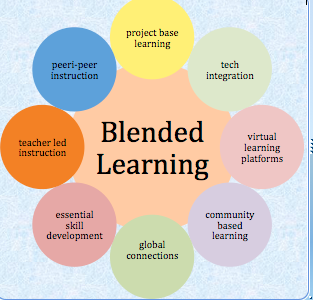In many ways technology has the potential to be the great equalizer in education due to the fact that technology can transform information into many different genre such as video, gaming, websites, and images. This ability to differentiate learning material means that we are finally at a point where we have the tools we need to make learning accessible to all students. The challenge now is to find ways to use technology and other methods to best adapt learning. For starters, I believe that embracing a blended learning environment--an environment of many tools, structures, and strategies simultaneously available to students for learning. The more students engage in this type of learning environment, the more he or she will understand, use, and create useful learning adaptations to further their success.
Standard II: Teaching All Students. The teacher promotes the learning and growth of all students through instructional practices that establish high expectations, create a safe and effective classroom environment, and demonstrate cultural proficiency
Indicator II-D. Expectations: Plans and implements lessons that set clear and high expectations and also make knowledge accessible for all students.
II-D-3: Access to Knowledge
Individually and with colleagues, consistently adapts instruction, materials, and assessments to make challenging material accessible to all students, including English learners and students with disabilities. Is able to model this element.
Key Points/Questions:
- Consistently adapts instruction, materials, and assessment to make challenging material accessible to all students. How do you adapt instructional and assessment materials in order to make challenging content accessible to all students?
- English language learners and students with disabilities: What processes, strategies, tools, and materials help you and your colleagues best adapt materials for English language learners and students with disabilities?
Key Points
|
Question
|
Effective Efforts
|
Implications for Your Practice
|
Results
|
Consistently adapts instruction, materials, and assessment to make challenging material accessible to all students.
|
How do you adapt instructional and assessment materials in order to make challenging content accessible to all students?
|
| ||
English language learners and students with disabilities:
|
What processes, strategies, tools, and materials help you and your colleagues best adapt materials for English language learners and students with disabilities?
|
|
My self analysis and action steps related to this element.
Reflections' Links
Reflections' Links
- Reflection #1 Subject Matter Knowledge
- Reflection #2 Child and Adolescent Behavior
- Reflection #3 Rigorous Standards-Based Unit Design
- Reflection #4 Well Structured Lessons
- Reflection #5 Variety of Assessment Methods
- Reflection #6 Adjustment to Practice
- Reflection #7 Analysis and Conclusions
- Reflection #8: Sharing Conclusions with Colleagues
- Reflection #9 Sharing Conclusions with Students
- Reflection #10: Quality of Effort and Work
- Reflection #11: Student Engagement
- Reflection #12: Meeting Diverse Needs
- Reflection #13: Safe Learning Environment
- Reflection #14: Collaborative Learning Environment
- Reflection #15: Student Motivation
- Reflection #16: Respects Differences
- Reflection #17: Maintains Respectful Environment
- Reflection #18: Clear Expectations
- Reflection #19 High Expectations
- Reflection #20 Access to Knowledge

